Net-Zero Energy Building Analysis and Design
VerifiedAdded on 2020/03/04
|18
|3806
|80
AI Summary
This assignment requires a critical analysis of various academic papers related to net-zero energy building (NZEB) concepts. The provided list includes journal articles and online sources that delve into NZEB design strategies, multigenerational system applications, energy performance assessments, renewable energy integration (like solar panels), waste utilization in energy production, and the impact of NZEBs on power systems. Students are expected to synthesize information from these papers to understand the current state-of-the-art in NZEB technology and its implications for sustainable building practices.
Contribute Materials
Your contribution can guide someone’s learning journey. Share your
documents today.
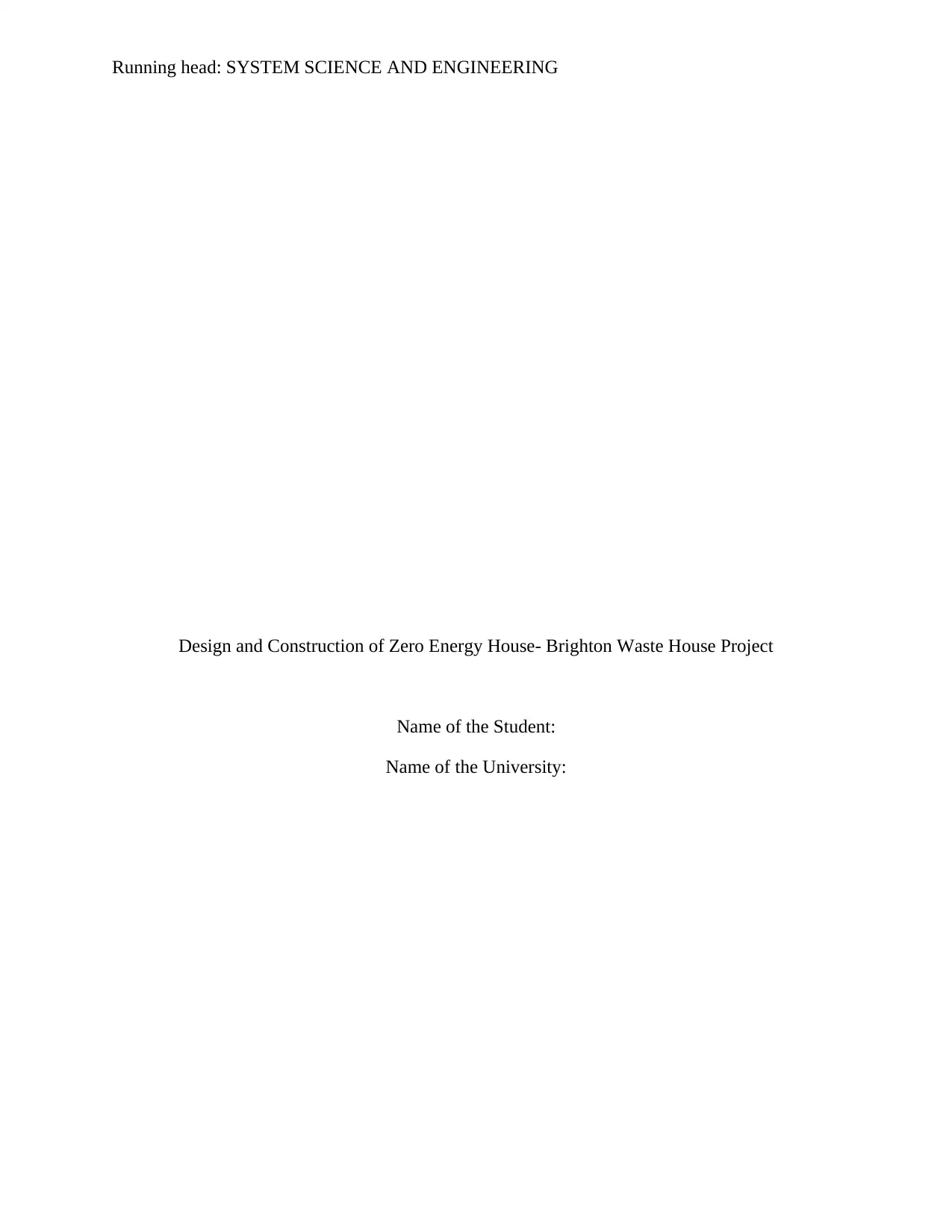
Running head: SYSTEM SCIENCE AND ENGINEERING
Design and Construction of Zero Energy House- Brighton Waste House Project
Name of the Student:
Name of the University:
Design and Construction of Zero Energy House- Brighton Waste House Project
Name of the Student:
Name of the University:
Secure Best Marks with AI Grader
Need help grading? Try our AI Grader for instant feedback on your assignments.
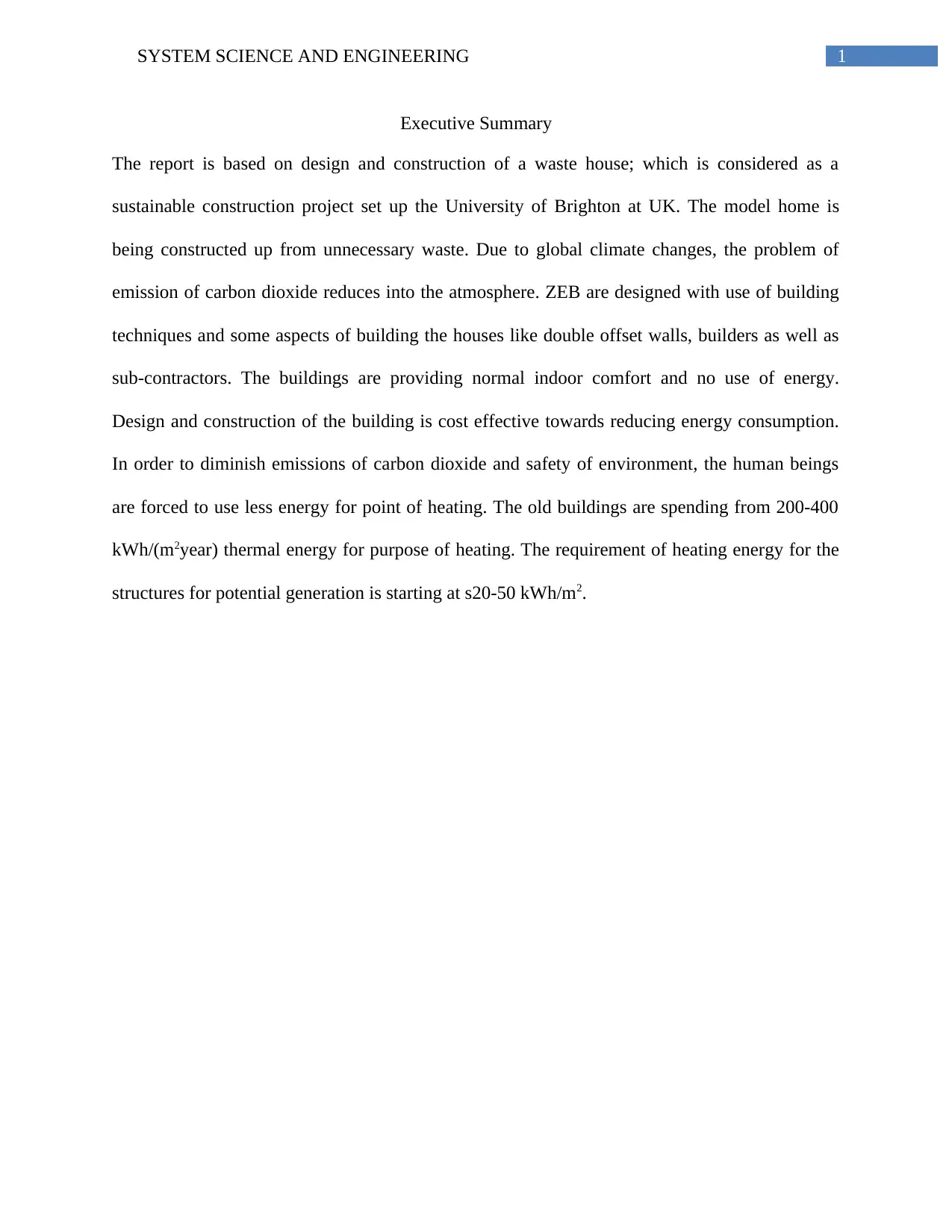
1SYSTEM SCIENCE AND ENGINEERING
Executive Summary
The report is based on design and construction of a waste house; which is considered as a
sustainable construction project set up the University of Brighton at UK. The model home is
being constructed up from unnecessary waste. Due to global climate changes, the problem of
emission of carbon dioxide reduces into the atmosphere. ZEB are designed with use of building
techniques and some aspects of building the houses like double offset walls, builders as well as
sub-contractors. The buildings are providing normal indoor comfort and no use of energy.
Design and construction of the building is cost effective towards reducing energy consumption.
In order to diminish emissions of carbon dioxide and safety of environment, the human beings
are forced to use less energy for point of heating. The old buildings are spending from 200-400
kWh/(m2year) thermal energy for purpose of heating. The requirement of heating energy for the
structures for potential generation is starting at s20-50 kWh/m2.
Executive Summary
The report is based on design and construction of a waste house; which is considered as a
sustainable construction project set up the University of Brighton at UK. The model home is
being constructed up from unnecessary waste. Due to global climate changes, the problem of
emission of carbon dioxide reduces into the atmosphere. ZEB are designed with use of building
techniques and some aspects of building the houses like double offset walls, builders as well as
sub-contractors. The buildings are providing normal indoor comfort and no use of energy.
Design and construction of the building is cost effective towards reducing energy consumption.
In order to diminish emissions of carbon dioxide and safety of environment, the human beings
are forced to use less energy for point of heating. The old buildings are spending from 200-400
kWh/(m2year) thermal energy for purpose of heating. The requirement of heating energy for the
structures for potential generation is starting at s20-50 kWh/m2.
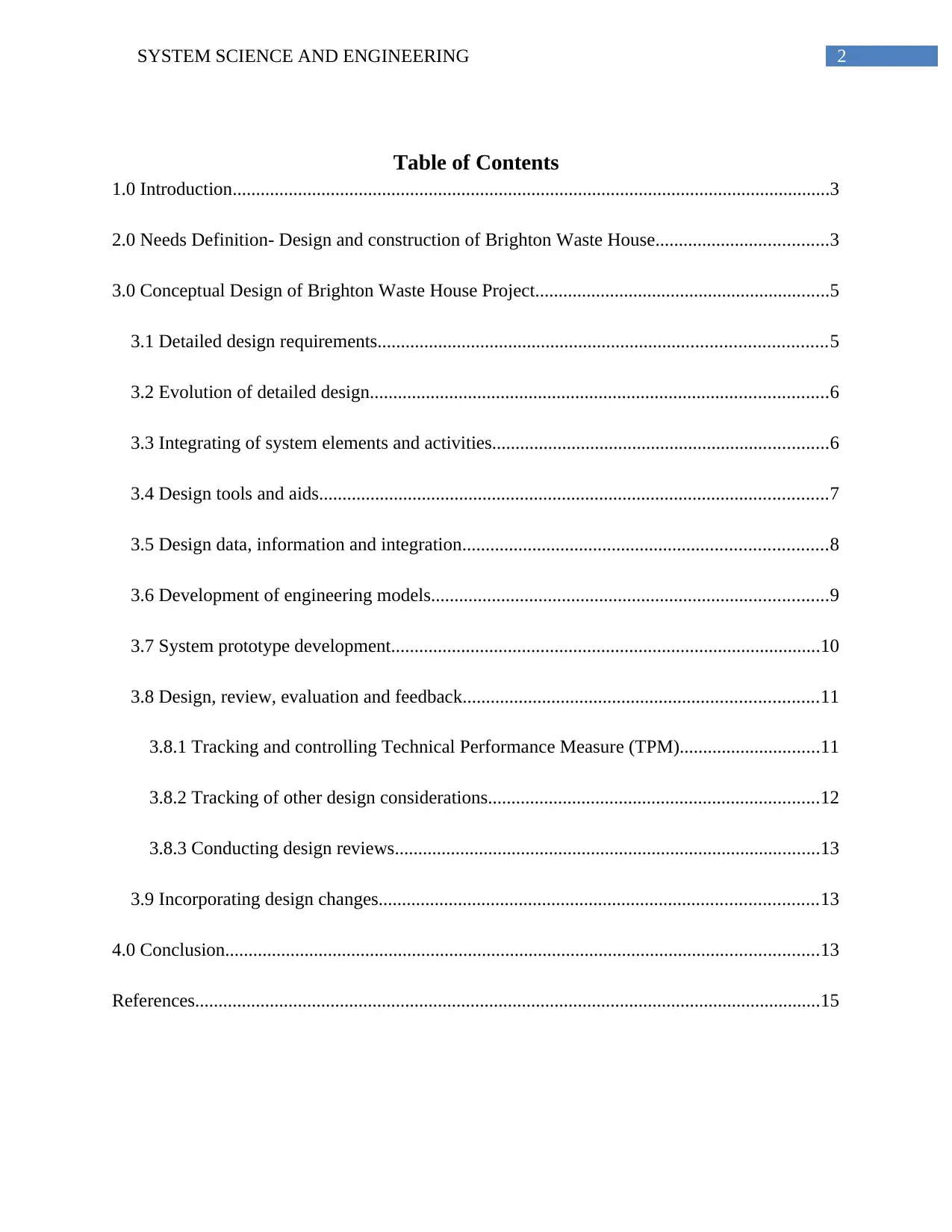
2SYSTEM SCIENCE AND ENGINEERING
Table of Contents
1.0 Introduction................................................................................................................................3
2.0 Needs Definition- Design and construction of Brighton Waste House.....................................3
3.0 Conceptual Design of Brighton Waste House Project...............................................................5
3.1 Detailed design requirements................................................................................................5
3.2 Evolution of detailed design..................................................................................................6
3.3 Integrating of system elements and activities........................................................................6
3.4 Design tools and aids.............................................................................................................7
3.5 Design data, information and integration..............................................................................8
3.6 Development of engineering models.....................................................................................9
3.7 System prototype development............................................................................................10
3.8 Design, review, evaluation and feedback............................................................................11
3.8.1 Tracking and controlling Technical Performance Measure (TPM)..............................11
3.8.2 Tracking of other design considerations.......................................................................12
3.8.3 Conducting design reviews...........................................................................................13
3.9 Incorporating design changes..............................................................................................13
4.0 Conclusion...............................................................................................................................13
References......................................................................................................................................15
Table of Contents
1.0 Introduction................................................................................................................................3
2.0 Needs Definition- Design and construction of Brighton Waste House.....................................3
3.0 Conceptual Design of Brighton Waste House Project...............................................................5
3.1 Detailed design requirements................................................................................................5
3.2 Evolution of detailed design..................................................................................................6
3.3 Integrating of system elements and activities........................................................................6
3.4 Design tools and aids.............................................................................................................7
3.5 Design data, information and integration..............................................................................8
3.6 Development of engineering models.....................................................................................9
3.7 System prototype development............................................................................................10
3.8 Design, review, evaluation and feedback............................................................................11
3.8.1 Tracking and controlling Technical Performance Measure (TPM)..............................11
3.8.2 Tracking of other design considerations.......................................................................12
3.8.3 Conducting design reviews...........................................................................................13
3.9 Incorporating design changes..............................................................................................13
4.0 Conclusion...............................................................................................................................13
References......................................................................................................................................15

3SYSTEM SCIENCE AND ENGINEERING
Secure Best Marks with AI Grader
Need help grading? Try our AI Grader for instant feedback on your assignments.
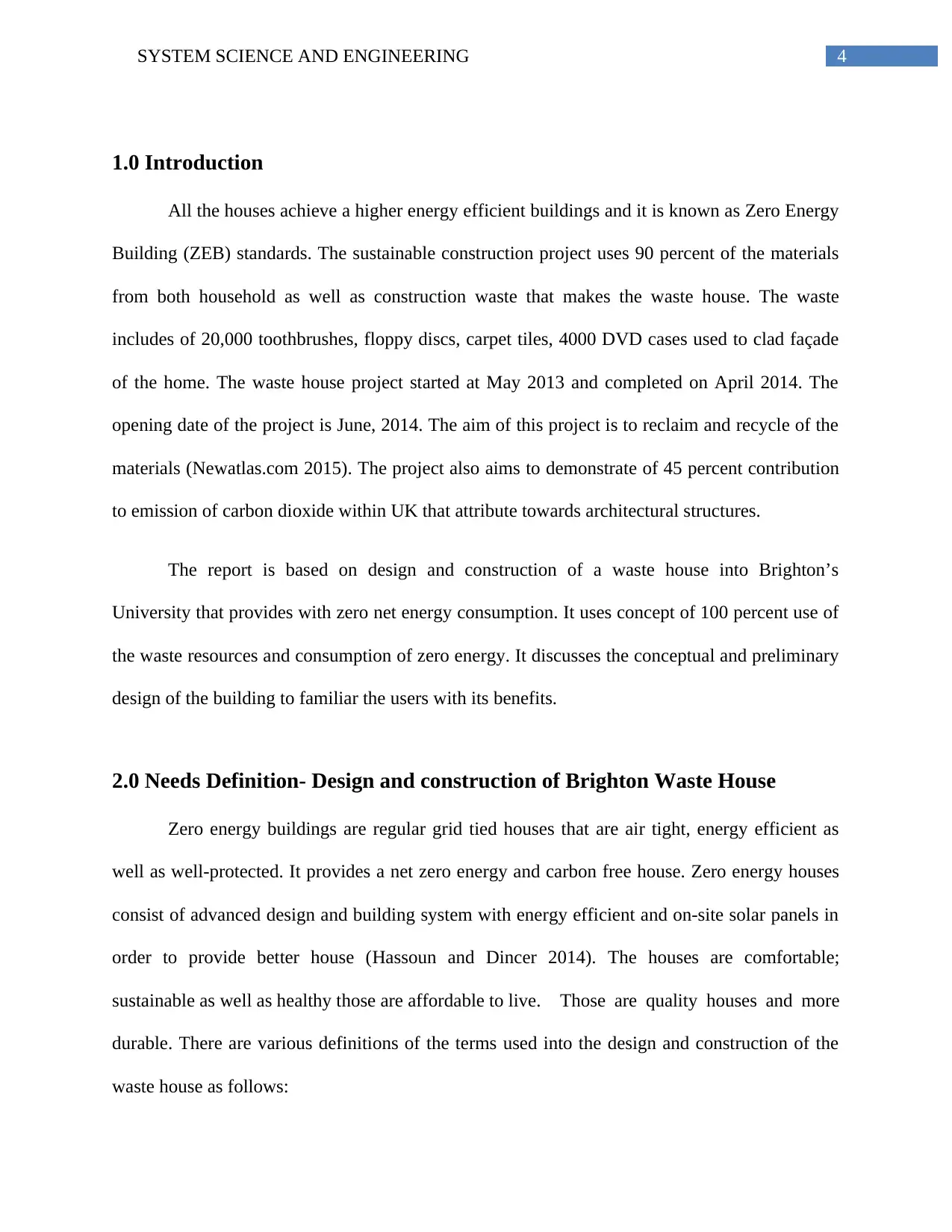
4SYSTEM SCIENCE AND ENGINEERING
1.0 Introduction
All the houses achieve a higher energy efficient buildings and it is known as Zero Energy
Building (ZEB) standards. The sustainable construction project uses 90 percent of the materials
from both household as well as construction waste that makes the waste house. The waste
includes of 20,000 toothbrushes, floppy discs, carpet tiles, 4000 DVD cases used to clad façade
of the home. The waste house project started at May 2013 and completed on April 2014. The
opening date of the project is June, 2014. The aim of this project is to reclaim and recycle of the
materials (Newatlas.com 2015). The project also aims to demonstrate of 45 percent contribution
to emission of carbon dioxide within UK that attribute towards architectural structures.
The report is based on design and construction of a waste house into Brighton’s
University that provides with zero net energy consumption. It uses concept of 100 percent use of
the waste resources and consumption of zero energy. It discusses the conceptual and preliminary
design of the building to familiar the users with its benefits.
2.0 Needs Definition- Design and construction of Brighton Waste House
Zero energy buildings are regular grid tied houses that are air tight, energy efficient as
well as well-protected. It provides a net zero energy and carbon free house. Zero energy houses
consist of advanced design and building system with energy efficient and on-site solar panels in
order to provide better house (Hassoun and Dincer 2014). The houses are comfortable;
sustainable as well as healthy those are affordable to live. Those are quality houses and more
durable. There are various definitions of the terms used into the design and construction of the
waste house as follows:
1.0 Introduction
All the houses achieve a higher energy efficient buildings and it is known as Zero Energy
Building (ZEB) standards. The sustainable construction project uses 90 percent of the materials
from both household as well as construction waste that makes the waste house. The waste
includes of 20,000 toothbrushes, floppy discs, carpet tiles, 4000 DVD cases used to clad façade
of the home. The waste house project started at May 2013 and completed on April 2014. The
opening date of the project is June, 2014. The aim of this project is to reclaim and recycle of the
materials (Newatlas.com 2015). The project also aims to demonstrate of 45 percent contribution
to emission of carbon dioxide within UK that attribute towards architectural structures.
The report is based on design and construction of a waste house into Brighton’s
University that provides with zero net energy consumption. It uses concept of 100 percent use of
the waste resources and consumption of zero energy. It discusses the conceptual and preliminary
design of the building to familiar the users with its benefits.
2.0 Needs Definition- Design and construction of Brighton Waste House
Zero energy buildings are regular grid tied houses that are air tight, energy efficient as
well as well-protected. It provides a net zero energy and carbon free house. Zero energy houses
consist of advanced design and building system with energy efficient and on-site solar panels in
order to provide better house (Hassoun and Dincer 2014). The houses are comfortable;
sustainable as well as healthy those are affordable to live. Those are quality houses and more
durable. There are various definitions of the terms used into the design and construction of the
waste house as follows:
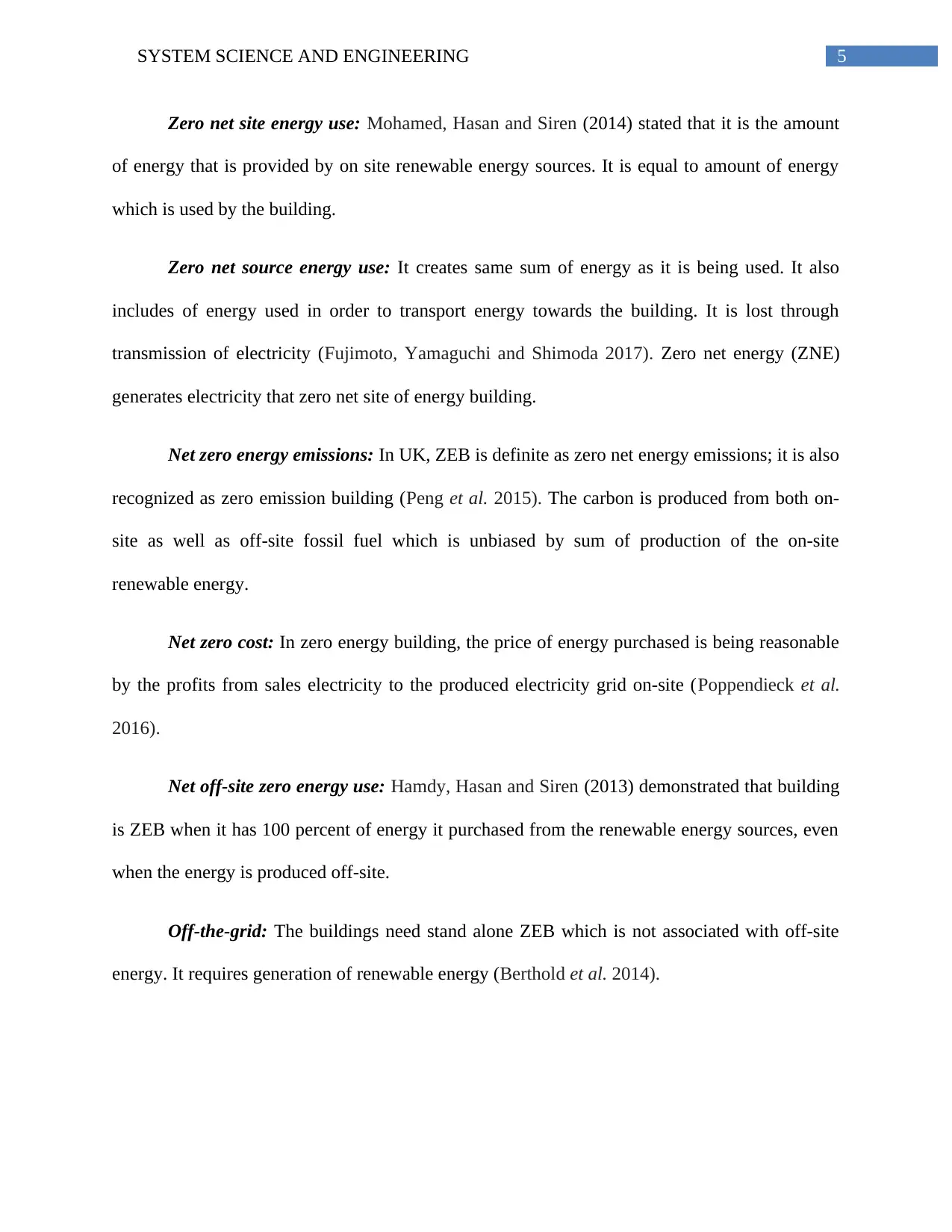
5SYSTEM SCIENCE AND ENGINEERING
Zero net site energy use: Mohamed, Hasan and Siren (2014) stated that it is the amount
of energy that is provided by on site renewable energy sources. It is equal to amount of energy
which is used by the building.
Zero net source energy use: It creates same sum of energy as it is being used. It also
includes of energy used in order to transport energy towards the building. It is lost through
transmission of electricity (Fujimoto, Yamaguchi and Shimoda 2017). Zero net energy (ZNE)
generates electricity that zero net site of energy building.
Net zero energy emissions: In UK, ZEB is definite as zero net energy emissions; it is also
recognized as zero emission building (Peng et al. 2015). The carbon is produced from both on-
site as well as off-site fossil fuel which is unbiased by sum of production of the on-site
renewable energy.
Net zero cost: In zero energy building, the price of energy purchased is being reasonable
by the profits from sales electricity to the produced electricity grid on-site (Poppendieck et al.
2016).
Net off-site zero energy use: Hamdy, Hasan and Siren (2013) demonstrated that building
is ZEB when it has 100 percent of energy it purchased from the renewable energy sources, even
when the energy is produced off-site.
Off-the-grid: The buildings need stand alone ZEB which is not associated with off-site
energy. It requires generation of renewable energy (Berthold et al. 2014).
Zero net site energy use: Mohamed, Hasan and Siren (2014) stated that it is the amount
of energy that is provided by on site renewable energy sources. It is equal to amount of energy
which is used by the building.
Zero net source energy use: It creates same sum of energy as it is being used. It also
includes of energy used in order to transport energy towards the building. It is lost through
transmission of electricity (Fujimoto, Yamaguchi and Shimoda 2017). Zero net energy (ZNE)
generates electricity that zero net site of energy building.
Net zero energy emissions: In UK, ZEB is definite as zero net energy emissions; it is also
recognized as zero emission building (Peng et al. 2015). The carbon is produced from both on-
site as well as off-site fossil fuel which is unbiased by sum of production of the on-site
renewable energy.
Net zero cost: In zero energy building, the price of energy purchased is being reasonable
by the profits from sales electricity to the produced electricity grid on-site (Poppendieck et al.
2016).
Net off-site zero energy use: Hamdy, Hasan and Siren (2013) demonstrated that building
is ZEB when it has 100 percent of energy it purchased from the renewable energy sources, even
when the energy is produced off-site.
Off-the-grid: The buildings need stand alone ZEB which is not associated with off-site
energy. It requires generation of renewable energy (Berthold et al. 2014).
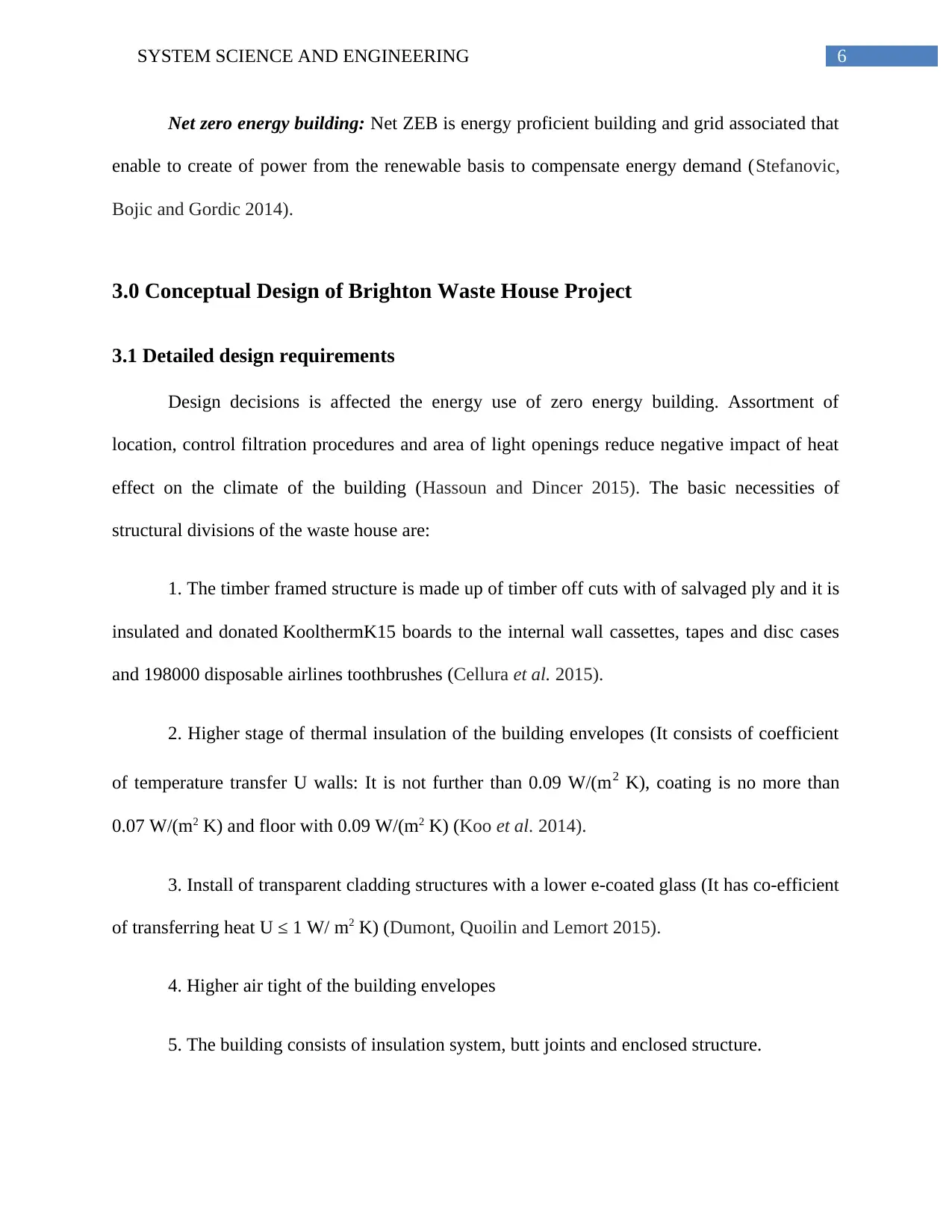
6SYSTEM SCIENCE AND ENGINEERING
Net zero energy building: Net ZEB is energy proficient building and grid associated that
enable to create of power from the renewable basis to compensate energy demand (Stefanovic,
Bojic and Gordic 2014).
3.0 Conceptual Design of Brighton Waste House Project
3.1 Detailed design requirements
Design decisions is affected the energy use of zero energy building. Assortment of
location, control filtration procedures and area of light openings reduce negative impact of heat
effect on the climate of the building (Hassoun and Dincer 2015). The basic necessities of
structural divisions of the waste house are:
1. The timber framed structure is made up of timber off cuts with of salvaged ply and it is
insulated and donated KoolthermK15 boards to the internal wall cassettes, tapes and disc cases
and 198000 disposable airlines toothbrushes (Cellura et al. 2015).
2. Higher stage of thermal insulation of the building envelopes (It consists of coefficient
of temperature transfer U walls: It is not further than 0.09 W/(m2 K), coating is no more than
0.07 W/(m2 K) and floor with 0.09 W/(m2 K) (Koo et al. 2014).
3. Install of transparent cladding structures with a lower e-coated glass (It has co-efficient
of transferring heat U ≤ 1 W/ m2 K) (Dumont, Quoilin and Lemort 2015).
4. Higher air tight of the building envelopes
5. The building consists of insulation system, butt joints and enclosed structure.
Net zero energy building: Net ZEB is energy proficient building and grid associated that
enable to create of power from the renewable basis to compensate energy demand (Stefanovic,
Bojic and Gordic 2014).
3.0 Conceptual Design of Brighton Waste House Project
3.1 Detailed design requirements
Design decisions is affected the energy use of zero energy building. Assortment of
location, control filtration procedures and area of light openings reduce negative impact of heat
effect on the climate of the building (Hassoun and Dincer 2015). The basic necessities of
structural divisions of the waste house are:
1. The timber framed structure is made up of timber off cuts with of salvaged ply and it is
insulated and donated KoolthermK15 boards to the internal wall cassettes, tapes and disc cases
and 198000 disposable airlines toothbrushes (Cellura et al. 2015).
2. Higher stage of thermal insulation of the building envelopes (It consists of coefficient
of temperature transfer U walls: It is not further than 0.09 W/(m2 K), coating is no more than
0.07 W/(m2 K) and floor with 0.09 W/(m2 K) (Koo et al. 2014).
3. Install of transparent cladding structures with a lower e-coated glass (It has co-efficient
of transferring heat U ≤ 1 W/ m2 K) (Dumont, Quoilin and Lemort 2015).
4. Higher air tight of the building envelopes
5. The building consists of insulation system, butt joints and enclosed structure.
Paraphrase This Document
Need a fresh take? Get an instant paraphrase of this document with our AI Paraphraser
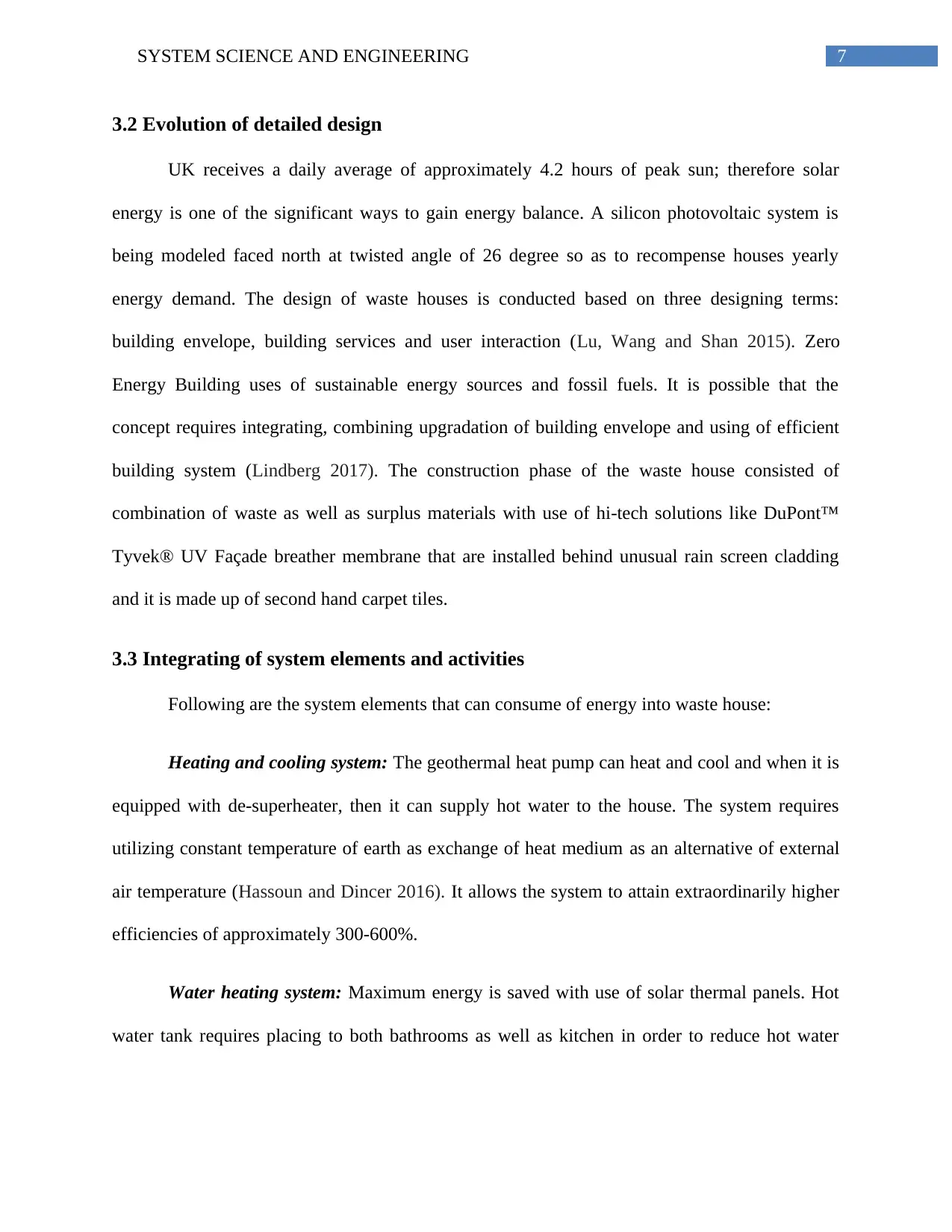
7SYSTEM SCIENCE AND ENGINEERING
3.2 Evolution of detailed design
UK receives a daily average of approximately 4.2 hours of peak sun; therefore solar
energy is one of the significant ways to gain energy balance. A silicon photovoltaic system is
being modeled faced north at twisted angle of 26 degree so as to recompense houses yearly
energy demand. The design of waste houses is conducted based on three designing terms:
building envelope, building services and user interaction (Lu, Wang and Shan 2015). Zero
Energy Building uses of sustainable energy sources and fossil fuels. It is possible that the
concept requires integrating, combining upgradation of building envelope and using of efficient
building system (Lindberg 2017). The construction phase of the waste house consisted of
combination of waste as well as surplus materials with use of hi-tech solutions like DuPont™
Tyvek® UV Façade breather membrane that are installed behind unusual rain screen cladding
and it is made up of second hand carpet tiles.
3.3 Integrating of system elements and activities
Following are the system elements that can consume of energy into waste house:
Heating and cooling system: The geothermal heat pump can heat and cool and when it is
equipped with de-superheater, then it can supply hot water to the house. The system requires
utilizing constant temperature of earth as exchange of heat medium as an alternative of external
air temperature (Hassoun and Dincer 2016). It allows the system to attain extraordinarily higher
efficiencies of approximately 300-600%.
Water heating system: Maximum energy is saved with use of solar thermal panels. Hot
water tank requires placing to both bathrooms as well as kitchen in order to reduce hot water
3.2 Evolution of detailed design
UK receives a daily average of approximately 4.2 hours of peak sun; therefore solar
energy is one of the significant ways to gain energy balance. A silicon photovoltaic system is
being modeled faced north at twisted angle of 26 degree so as to recompense houses yearly
energy demand. The design of waste houses is conducted based on three designing terms:
building envelope, building services and user interaction (Lu, Wang and Shan 2015). Zero
Energy Building uses of sustainable energy sources and fossil fuels. It is possible that the
concept requires integrating, combining upgradation of building envelope and using of efficient
building system (Lindberg 2017). The construction phase of the waste house consisted of
combination of waste as well as surplus materials with use of hi-tech solutions like DuPont™
Tyvek® UV Façade breather membrane that are installed behind unusual rain screen cladding
and it is made up of second hand carpet tiles.
3.3 Integrating of system elements and activities
Following are the system elements that can consume of energy into waste house:
Heating and cooling system: The geothermal heat pump can heat and cool and when it is
equipped with de-superheater, then it can supply hot water to the house. The system requires
utilizing constant temperature of earth as exchange of heat medium as an alternative of external
air temperature (Hassoun and Dincer 2016). It allows the system to attain extraordinarily higher
efficiencies of approximately 300-600%.
Water heating system: Maximum energy is saved with use of solar thermal panels. Hot
water tank requires placing to both bathrooms as well as kitchen in order to reduce hot water
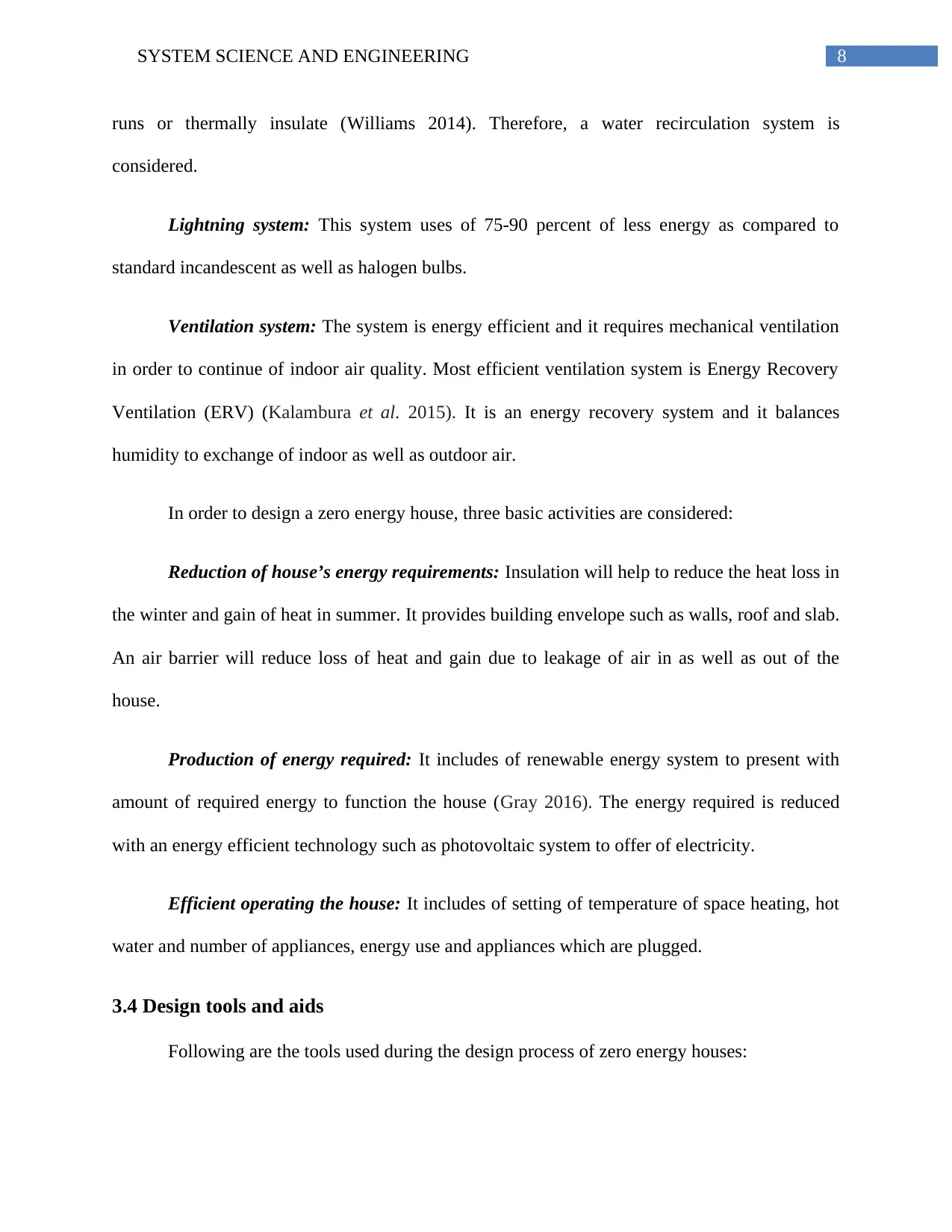
8SYSTEM SCIENCE AND ENGINEERING
runs or thermally insulate (Williams 2014). Therefore, a water recirculation system is
considered.
Lightning system: This system uses of 75-90 percent of less energy as compared to
standard incandescent as well as halogen bulbs.
Ventilation system: The system is energy efficient and it requires mechanical ventilation
in order to continue of indoor air quality. Most efficient ventilation system is Energy Recovery
Ventilation (ERV) (Kalambura et al. 2015). It is an energy recovery system and it balances
humidity to exchange of indoor as well as outdoor air.
In order to design a zero energy house, three basic activities are considered:
Reduction of house’s energy requirements: Insulation will help to reduce the heat loss in
the winter and gain of heat in summer. It provides building envelope such as walls, roof and slab.
An air barrier will reduce loss of heat and gain due to leakage of air in as well as out of the
house.
Production of energy required: It includes of renewable energy system to present with
amount of required energy to function the house (Gray 2016). The energy required is reduced
with an energy efficient technology such as photovoltaic system to offer of electricity.
Efficient operating the house: It includes of setting of temperature of space heating, hot
water and number of appliances, energy use and appliances which are plugged.
3.4 Design tools and aids
Following are the tools used during the design process of zero energy houses:
runs or thermally insulate (Williams 2014). Therefore, a water recirculation system is
considered.
Lightning system: This system uses of 75-90 percent of less energy as compared to
standard incandescent as well as halogen bulbs.
Ventilation system: The system is energy efficient and it requires mechanical ventilation
in order to continue of indoor air quality. Most efficient ventilation system is Energy Recovery
Ventilation (ERV) (Kalambura et al. 2015). It is an energy recovery system and it balances
humidity to exchange of indoor as well as outdoor air.
In order to design a zero energy house, three basic activities are considered:
Reduction of house’s energy requirements: Insulation will help to reduce the heat loss in
the winter and gain of heat in summer. It provides building envelope such as walls, roof and slab.
An air barrier will reduce loss of heat and gain due to leakage of air in as well as out of the
house.
Production of energy required: It includes of renewable energy system to present with
amount of required energy to function the house (Gray 2016). The energy required is reduced
with an energy efficient technology such as photovoltaic system to offer of electricity.
Efficient operating the house: It includes of setting of temperature of space heating, hot
water and number of appliances, energy use and appliances which are plugged.
3.4 Design tools and aids
Following are the tools used during the design process of zero energy houses:
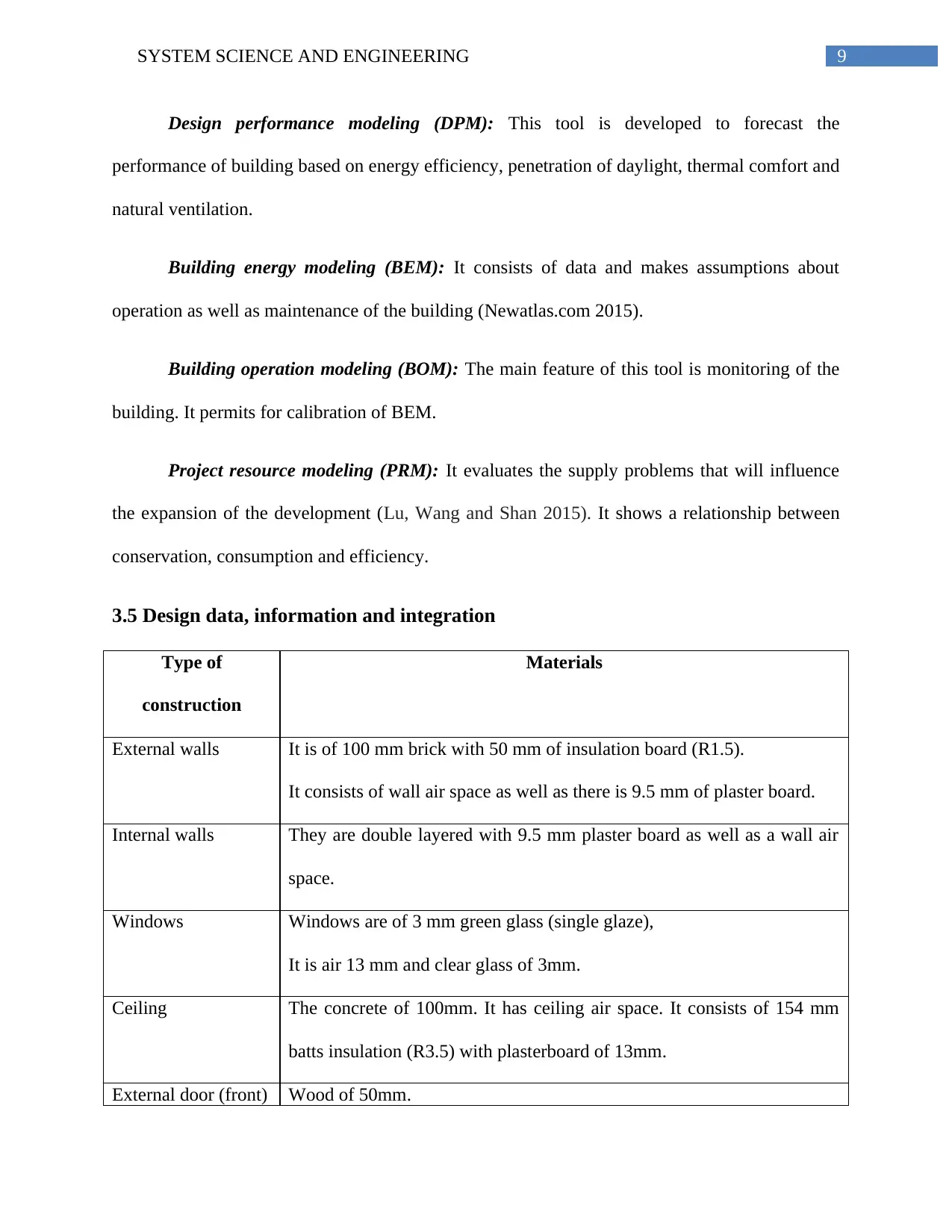
9SYSTEM SCIENCE AND ENGINEERING
Design performance modeling (DPM): This tool is developed to forecast the
performance of building based on energy efficiency, penetration of daylight, thermal comfort and
natural ventilation.
Building energy modeling (BEM): It consists of data and makes assumptions about
operation as well as maintenance of the building (Newatlas.com 2015).
Building operation modeling (BOM): The main feature of this tool is monitoring of the
building. It permits for calibration of BEM.
Project resource modeling (PRM): It evaluates the supply problems that will influence
the expansion of the development (Lu, Wang and Shan 2015). It shows a relationship between
conservation, consumption and efficiency.
3.5 Design data, information and integration
Type of
construction
Materials
External walls It is of 100 mm brick with 50 mm of insulation board (R1.5).
It consists of wall air space as well as there is 9.5 mm of plaster board.
Internal walls They are double layered with 9.5 mm plaster board as well as a wall air
space.
Windows Windows are of 3 mm green glass (single glaze),
It is air 13 mm and clear glass of 3mm.
Ceiling The concrete of 100mm. It has ceiling air space. It consists of 154 mm
batts insulation (R3.5) with plasterboard of 13mm.
External door (front) Wood of 50mm.
Design performance modeling (DPM): This tool is developed to forecast the
performance of building based on energy efficiency, penetration of daylight, thermal comfort and
natural ventilation.
Building energy modeling (BEM): It consists of data and makes assumptions about
operation as well as maintenance of the building (Newatlas.com 2015).
Building operation modeling (BOM): The main feature of this tool is monitoring of the
building. It permits for calibration of BEM.
Project resource modeling (PRM): It evaluates the supply problems that will influence
the expansion of the development (Lu, Wang and Shan 2015). It shows a relationship between
conservation, consumption and efficiency.
3.5 Design data, information and integration
Type of
construction
Materials
External walls It is of 100 mm brick with 50 mm of insulation board (R1.5).
It consists of wall air space as well as there is 9.5 mm of plaster board.
Internal walls They are double layered with 9.5 mm plaster board as well as a wall air
space.
Windows Windows are of 3 mm green glass (single glaze),
It is air 13 mm and clear glass of 3mm.
Ceiling The concrete of 100mm. It has ceiling air space. It consists of 154 mm
batts insulation (R3.5) with plasterboard of 13mm.
External door (front) Wood of 50mm.
Secure Best Marks with AI Grader
Need help grading? Try our AI Grader for instant feedback on your assignments.
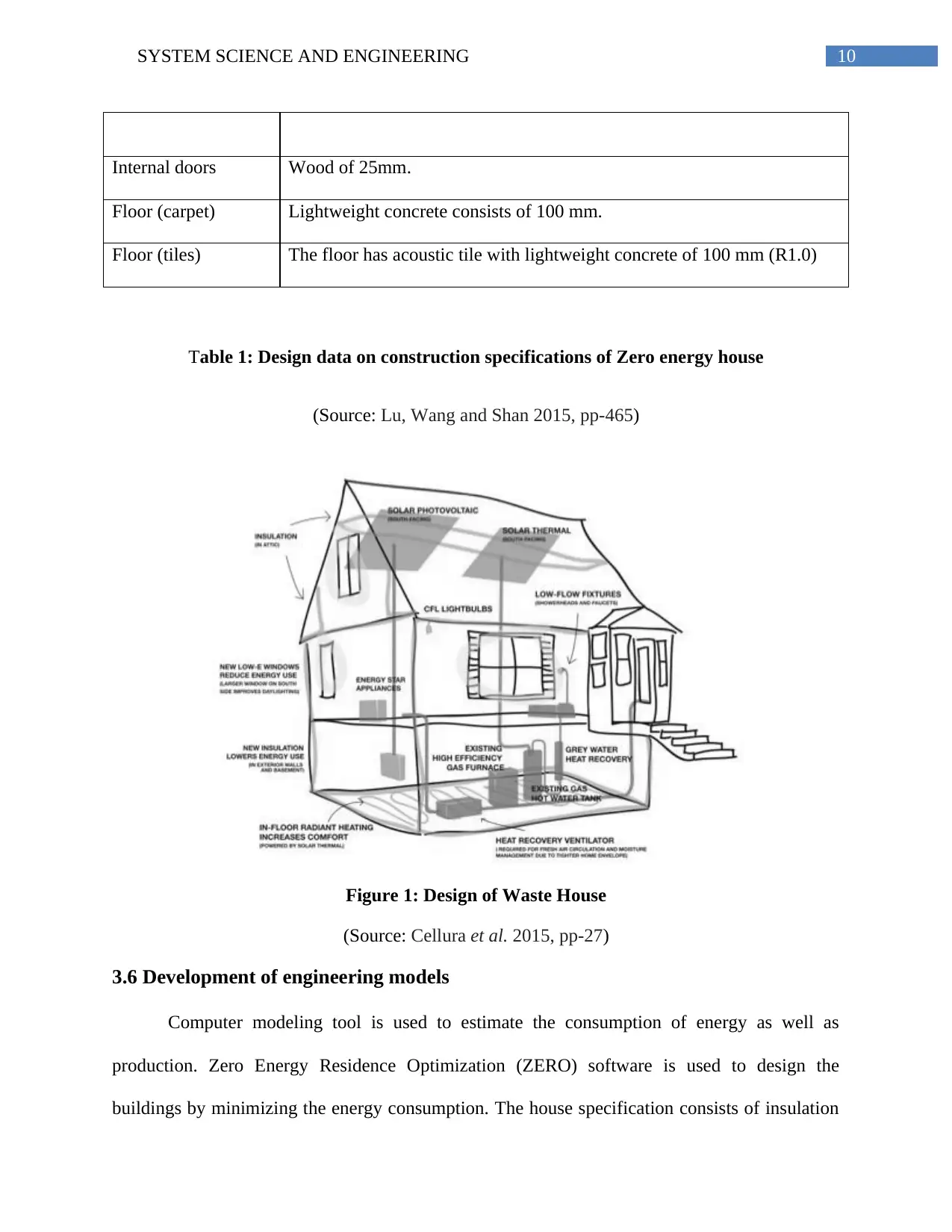
10SYSTEM SCIENCE AND ENGINEERING
Internal doors Wood of 25mm.
Floor (carpet) Lightweight concrete consists of 100 mm.
Floor (tiles) The floor has acoustic tile with lightweight concrete of 100 mm (R1.0)
Table 1: Design data on construction specifications of Zero energy house
(Source: Lu, Wang and Shan 2015, pp-465)
Figure 1: Design of Waste House
(Source: Cellura et al. 2015, pp-27)
3.6 Development of engineering models
Computer modeling tool is used to estimate the consumption of energy as well as
production. Zero Energy Residence Optimization (ZERO) software is used to design the
buildings by minimizing the energy consumption. The house specification consists of insulation
Internal doors Wood of 25mm.
Floor (carpet) Lightweight concrete consists of 100 mm.
Floor (tiles) The floor has acoustic tile with lightweight concrete of 100 mm (R1.0)
Table 1: Design data on construction specifications of Zero energy house
(Source: Lu, Wang and Shan 2015, pp-465)
Figure 1: Design of Waste House
(Source: Cellura et al. 2015, pp-27)
3.6 Development of engineering models
Computer modeling tool is used to estimate the consumption of energy as well as
production. Zero Energy Residence Optimization (ZERO) software is used to design the
buildings by minimizing the energy consumption. The house specification consists of insulation
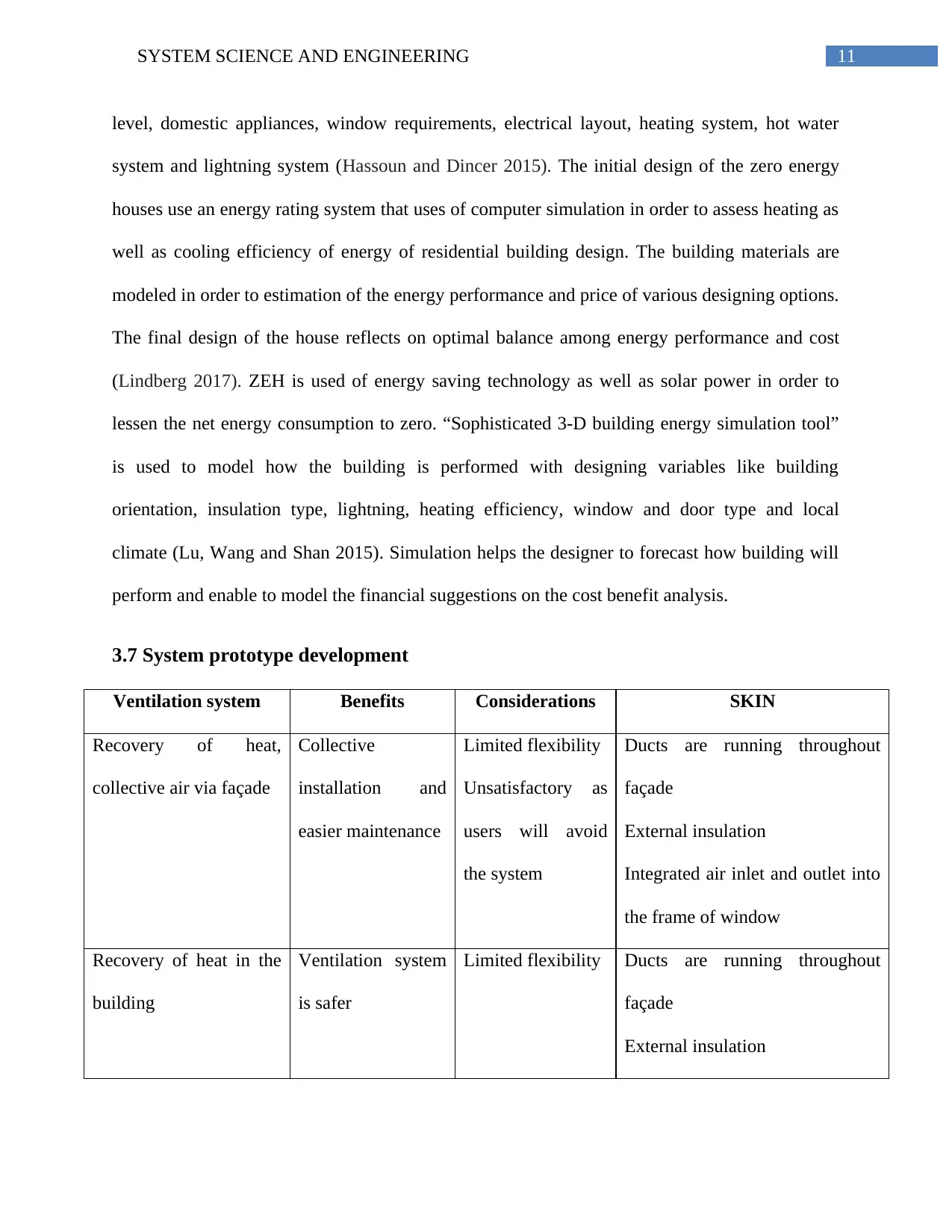
11SYSTEM SCIENCE AND ENGINEERING
level, domestic appliances, window requirements, electrical layout, heating system, hot water
system and lightning system (Hassoun and Dincer 2015). The initial design of the zero energy
houses use an energy rating system that uses of computer simulation in order to assess heating as
well as cooling efficiency of energy of residential building design. The building materials are
modeled in order to estimation of the energy performance and price of various designing options.
The final design of the house reflects on optimal balance among energy performance and cost
(Lindberg 2017). ZEH is used of energy saving technology as well as solar power in order to
lessen the net energy consumption to zero. “Sophisticated 3-D building energy simulation tool”
is used to model how the building is performed with designing variables like building
orientation, insulation type, lightning, heating efficiency, window and door type and local
climate (Lu, Wang and Shan 2015). Simulation helps the designer to forecast how building will
perform and enable to model the financial suggestions on the cost benefit analysis.
3.7 System prototype development
Ventilation system Benefits Considerations SKIN
Recovery of heat,
collective air via façade
Collective
installation and
easier maintenance
Limited flexibility
Unsatisfactory as
users will avoid
the system
Ducts are running throughout
façade
External insulation
Integrated air inlet and outlet into
the frame of window
Recovery of heat in the
building
Ventilation system
is safer
Limited flexibility Ducts are running throughout
façade
External insulation
level, domestic appliances, window requirements, electrical layout, heating system, hot water
system and lightning system (Hassoun and Dincer 2015). The initial design of the zero energy
houses use an energy rating system that uses of computer simulation in order to assess heating as
well as cooling efficiency of energy of residential building design. The building materials are
modeled in order to estimation of the energy performance and price of various designing options.
The final design of the house reflects on optimal balance among energy performance and cost
(Lindberg 2017). ZEH is used of energy saving technology as well as solar power in order to
lessen the net energy consumption to zero. “Sophisticated 3-D building energy simulation tool”
is used to model how the building is performed with designing variables like building
orientation, insulation type, lightning, heating efficiency, window and door type and local
climate (Lu, Wang and Shan 2015). Simulation helps the designer to forecast how building will
perform and enable to model the financial suggestions on the cost benefit analysis.
3.7 System prototype development
Ventilation system Benefits Considerations SKIN
Recovery of heat,
collective air via façade
Collective
installation and
easier maintenance
Limited flexibility
Unsatisfactory as
users will avoid
the system
Ducts are running throughout
façade
External insulation
Integrated air inlet and outlet into
the frame of window
Recovery of heat in the
building
Ventilation system
is safer
Limited flexibility Ducts are running throughout
façade
External insulation
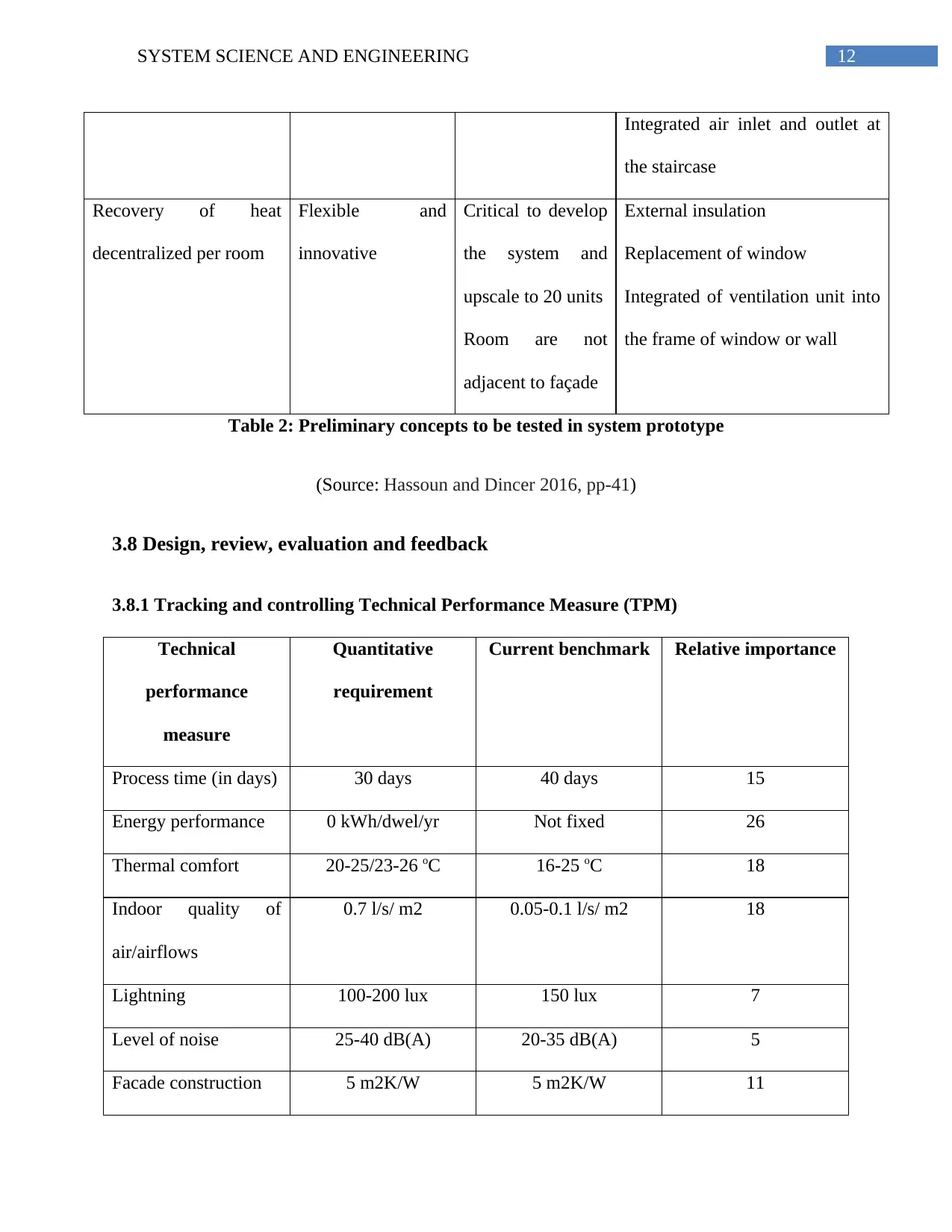
12SYSTEM SCIENCE AND ENGINEERING
Integrated air inlet and outlet at
the staircase
Recovery of heat
decentralized per room
Flexible and
innovative
Critical to develop
the system and
upscale to 20 units
Room are not
adjacent to façade
External insulation
Replacement of window
Integrated of ventilation unit into
the frame of window or wall
Table 2: Preliminary concepts to be tested in system prototype
(Source: Hassoun and Dincer 2016, pp-41)
3.8 Design, review, evaluation and feedback
3.8.1 Tracking and controlling Technical Performance Measure (TPM)
Technical
performance
measure
Quantitative
requirement
Current benchmark Relative importance
Process time (in days) 30 days 40 days 15
Energy performance 0 kWh/dwel/yr Not fixed 26
Thermal comfort 20-25/23-26 oC 16-25 oC 18
Indoor quality of
air/airflows
0.7 l/s/ m2 0.05-0.1 l/s/ m2 18
Lightning 100-200 lux 150 lux 7
Level of noise 25-40 dB(A) 20-35 dB(A) 5
Facade construction 5 m2K/W 5 m2K/W 11
Integrated air inlet and outlet at
the staircase
Recovery of heat
decentralized per room
Flexible and
innovative
Critical to develop
the system and
upscale to 20 units
Room are not
adjacent to façade
External insulation
Replacement of window
Integrated of ventilation unit into
the frame of window or wall
Table 2: Preliminary concepts to be tested in system prototype
(Source: Hassoun and Dincer 2016, pp-41)
3.8 Design, review, evaluation and feedback
3.8.1 Tracking and controlling Technical Performance Measure (TPM)
Technical
performance
measure
Quantitative
requirement
Current benchmark Relative importance
Process time (in days) 30 days 40 days 15
Energy performance 0 kWh/dwel/yr Not fixed 26
Thermal comfort 20-25/23-26 oC 16-25 oC 18
Indoor quality of
air/airflows
0.7 l/s/ m2 0.05-0.1 l/s/ m2 18
Lightning 100-200 lux 150 lux 7
Level of noise 25-40 dB(A) 20-35 dB(A) 5
Facade construction 5 m2K/W 5 m2K/W 11
Paraphrase This Document
Need a fresh take? Get an instant paraphrase of this document with our AI Paraphraser
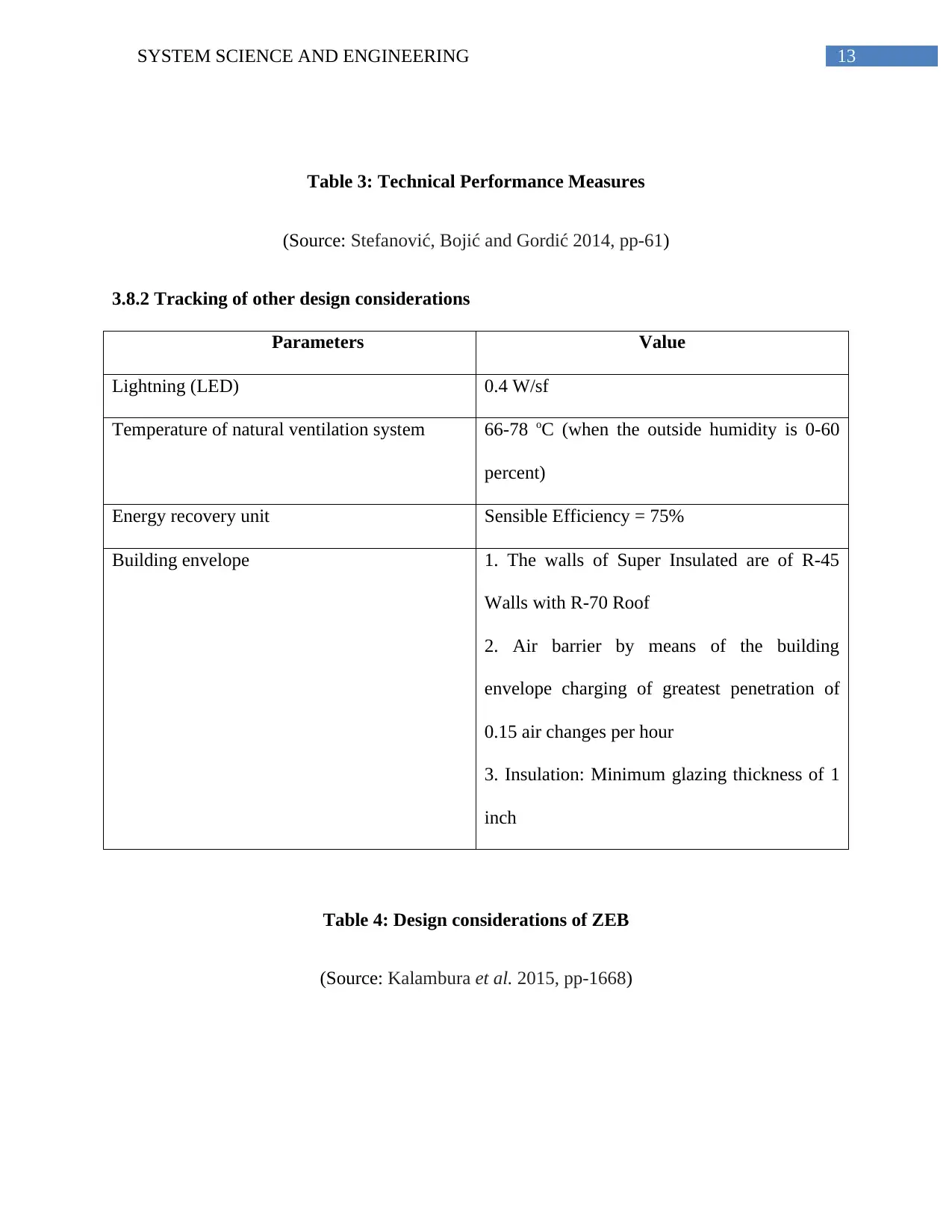
13SYSTEM SCIENCE AND ENGINEERING
Table 3: Technical Performance Measures
(Source: Stefanović, Bojić and Gordić 2014, pp-61)
3.8.2 Tracking of other design considerations
Parameters Value
Lightning (LED) 0.4 W/sf
Temperature of natural ventilation system 66-78 oC (when the outside humidity is 0-60
percent)
Energy recovery unit Sensible Efficiency = 75%
Building envelope 1. The walls of Super Insulated are of R-45
Walls with R-70 Roof
2. Air barrier by means of the building
envelope charging of greatest penetration of
0.15 air changes per hour
3. Insulation: Minimum glazing thickness of 1
inch
Table 4: Design considerations of ZEB
(Source: Kalambura et al. 2015, pp-1668)
Table 3: Technical Performance Measures
(Source: Stefanović, Bojić and Gordić 2014, pp-61)
3.8.2 Tracking of other design considerations
Parameters Value
Lightning (LED) 0.4 W/sf
Temperature of natural ventilation system 66-78 oC (when the outside humidity is 0-60
percent)
Energy recovery unit Sensible Efficiency = 75%
Building envelope 1. The walls of Super Insulated are of R-45
Walls with R-70 Roof
2. Air barrier by means of the building
envelope charging of greatest penetration of
0.15 air changes per hour
3. Insulation: Minimum glazing thickness of 1
inch
Table 4: Design considerations of ZEB
(Source: Kalambura et al. 2015, pp-1668)
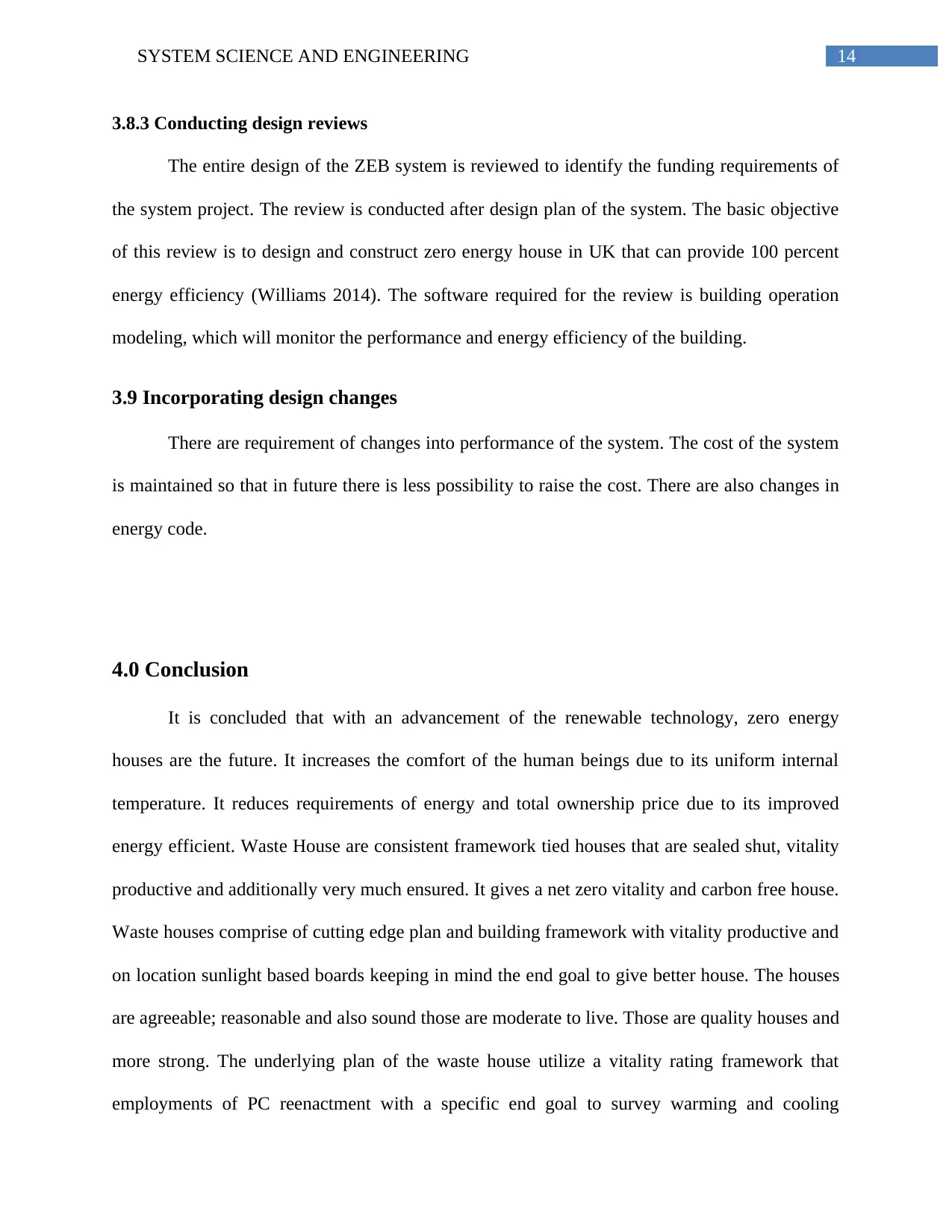
14SYSTEM SCIENCE AND ENGINEERING
3.8.3 Conducting design reviews
The entire design of the ZEB system is reviewed to identify the funding requirements of
the system project. The review is conducted after design plan of the system. The basic objective
of this review is to design and construct zero energy house in UK that can provide 100 percent
energy efficiency (Williams 2014). The software required for the review is building operation
modeling, which will monitor the performance and energy efficiency of the building.
3.9 Incorporating design changes
There are requirement of changes into performance of the system. The cost of the system
is maintained so that in future there is less possibility to raise the cost. There are also changes in
energy code.
4.0 Conclusion
It is concluded that with an advancement of the renewable technology, zero energy
houses are the future. It increases the comfort of the human beings due to its uniform internal
temperature. It reduces requirements of energy and total ownership price due to its improved
energy efficient. Waste House are consistent framework tied houses that are sealed shut, vitality
productive and additionally very much ensured. It gives a net zero vitality and carbon free house.
Waste houses comprise of cutting edge plan and building framework with vitality productive and
on location sunlight based boards keeping in mind the end goal to give better house. The houses
are agreeable; reasonable and also sound those are moderate to live. Those are quality houses and
more strong. The underlying plan of the waste house utilize a vitality rating framework that
employments of PC reenactment with a specific end goal to survey warming and cooling
3.8.3 Conducting design reviews
The entire design of the ZEB system is reviewed to identify the funding requirements of
the system project. The review is conducted after design plan of the system. The basic objective
of this review is to design and construct zero energy house in UK that can provide 100 percent
energy efficiency (Williams 2014). The software required for the review is building operation
modeling, which will monitor the performance and energy efficiency of the building.
3.9 Incorporating design changes
There are requirement of changes into performance of the system. The cost of the system
is maintained so that in future there is less possibility to raise the cost. There are also changes in
energy code.
4.0 Conclusion
It is concluded that with an advancement of the renewable technology, zero energy
houses are the future. It increases the comfort of the human beings due to its uniform internal
temperature. It reduces requirements of energy and total ownership price due to its improved
energy efficient. Waste House are consistent framework tied houses that are sealed shut, vitality
productive and additionally very much ensured. It gives a net zero vitality and carbon free house.
Waste houses comprise of cutting edge plan and building framework with vitality productive and
on location sunlight based boards keeping in mind the end goal to give better house. The houses
are agreeable; reasonable and also sound those are moderate to live. Those are quality houses and
more strong. The underlying plan of the waste house utilize a vitality rating framework that
employments of PC reenactment with a specific end goal to survey warming and cooling
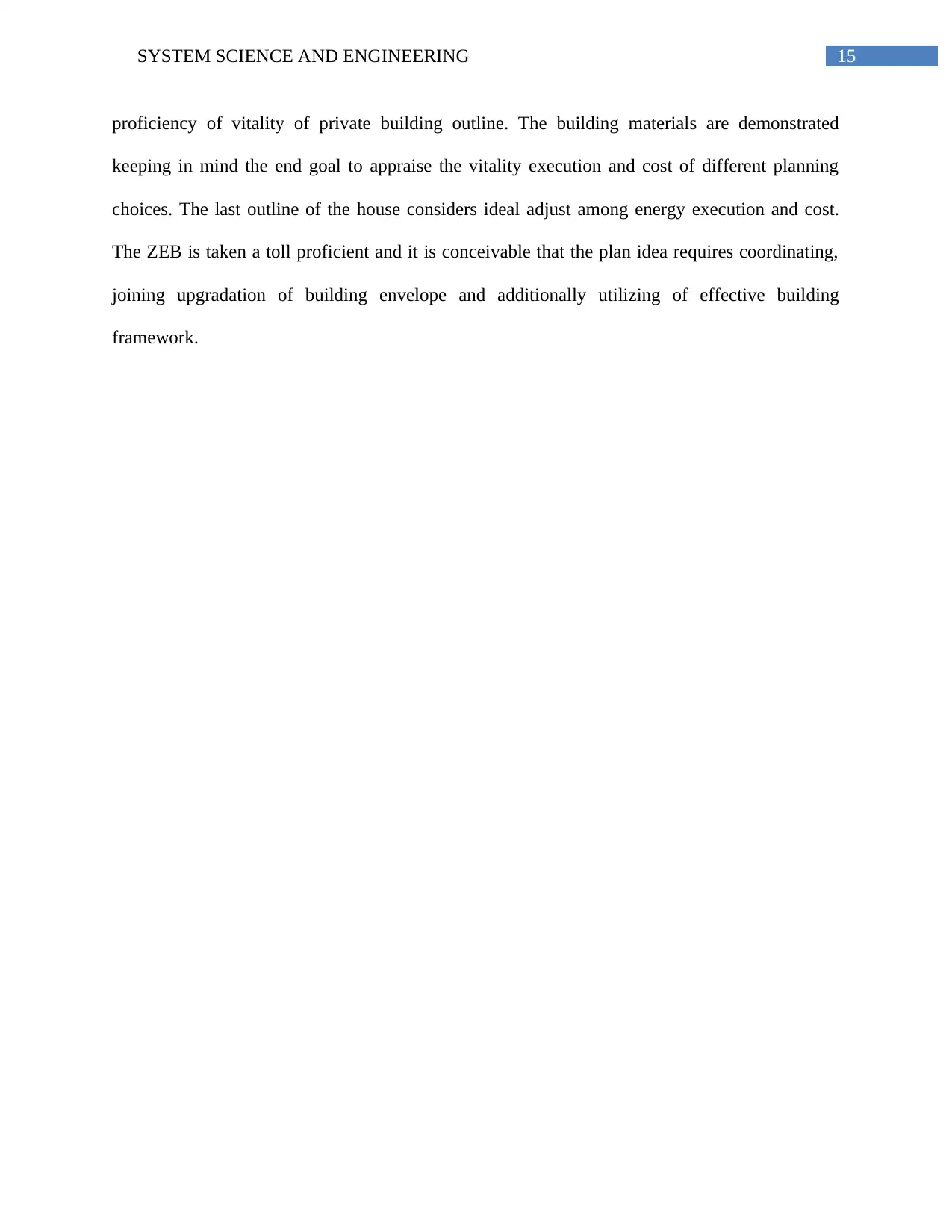
15SYSTEM SCIENCE AND ENGINEERING
proficiency of vitality of private building outline. The building materials are demonstrated
keeping in mind the end goal to appraise the vitality execution and cost of different planning
choices. The last outline of the house considers ideal adjust among energy execution and cost.
The ZEB is taken a toll proficient and it is conceivable that the plan idea requires coordinating,
joining upgradation of building envelope and additionally utilizing of effective building
framework.
proficiency of vitality of private building outline. The building materials are demonstrated
keeping in mind the end goal to appraise the vitality execution and cost of different planning
choices. The last outline of the house considers ideal adjust among energy execution and cost.
The ZEB is taken a toll proficient and it is conceivable that the plan idea requires coordinating,
joining upgradation of building envelope and additionally utilizing of effective building
framework.
Secure Best Marks with AI Grader
Need help grading? Try our AI Grader for instant feedback on your assignments.
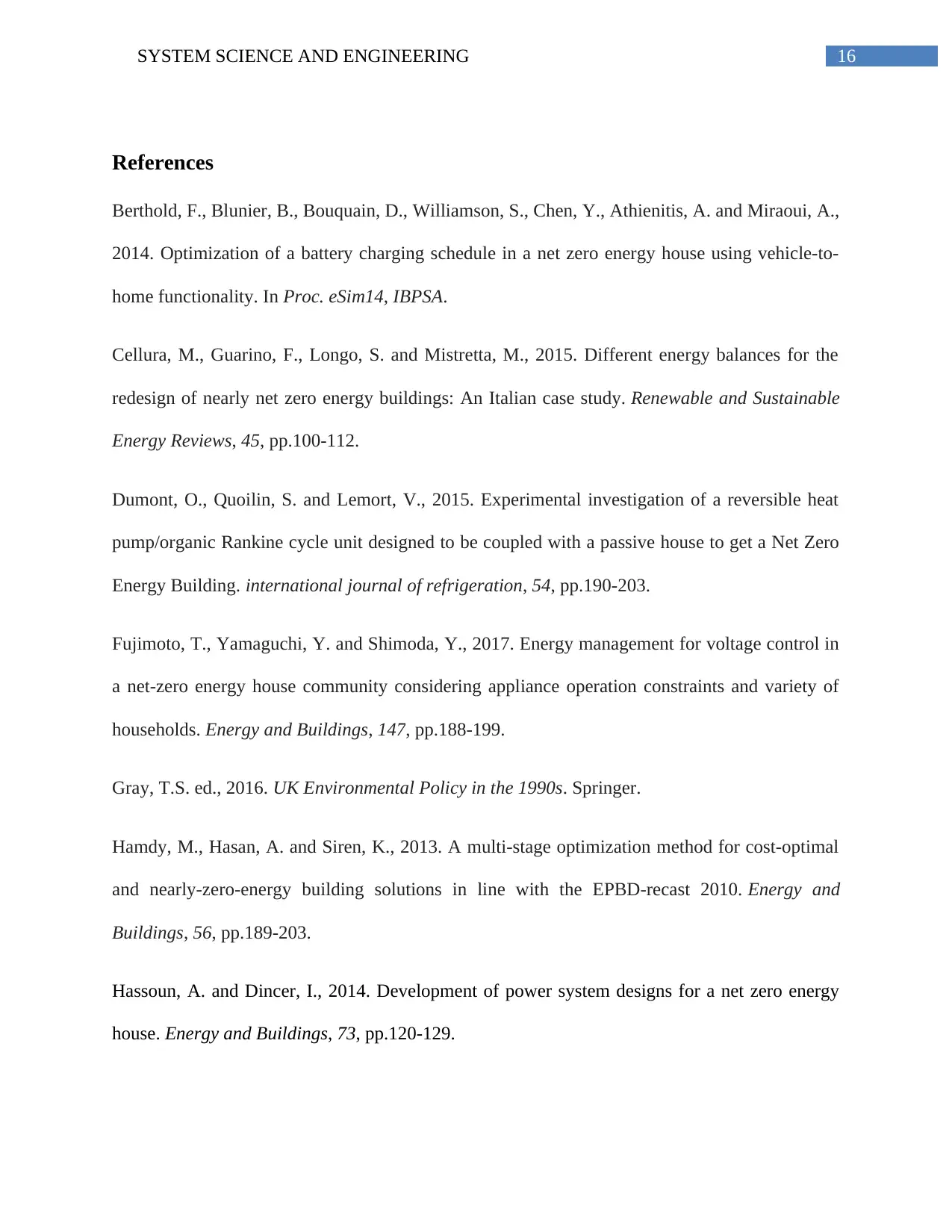
16SYSTEM SCIENCE AND ENGINEERING
References
Berthold, F., Blunier, B., Bouquain, D., Williamson, S., Chen, Y., Athienitis, A. and Miraoui, A.,
2014. Optimization of a battery charging schedule in a net zero energy house using vehicle-to-
home functionality. In Proc. eSim14, IBPSA.
Cellura, M., Guarino, F., Longo, S. and Mistretta, M., 2015. Different energy balances for the
redesign of nearly net zero energy buildings: An Italian case study. Renewable and Sustainable
Energy Reviews, 45, pp.100-112.
Dumont, O., Quoilin, S. and Lemort, V., 2015. Experimental investigation of a reversible heat
pump/organic Rankine cycle unit designed to be coupled with a passive house to get a Net Zero
Energy Building. international journal of refrigeration, 54, pp.190-203.
Fujimoto, T., Yamaguchi, Y. and Shimoda, Y., 2017. Energy management for voltage control in
a net-zero energy house community considering appliance operation constraints and variety of
households. Energy and Buildings, 147, pp.188-199.
Gray, T.S. ed., 2016. UK Environmental Policy in the 1990s. Springer.
Hamdy, M., Hasan, A. and Siren, K., 2013. A multi-stage optimization method for cost-optimal
and nearly-zero-energy building solutions in line with the EPBD-recast 2010. Energy and
Buildings, 56, pp.189-203.
Hassoun, A. and Dincer, I., 2014. Development of power system designs for a net zero energy
house. Energy and Buildings, 73, pp.120-129.
References
Berthold, F., Blunier, B., Bouquain, D., Williamson, S., Chen, Y., Athienitis, A. and Miraoui, A.,
2014. Optimization of a battery charging schedule in a net zero energy house using vehicle-to-
home functionality. In Proc. eSim14, IBPSA.
Cellura, M., Guarino, F., Longo, S. and Mistretta, M., 2015. Different energy balances for the
redesign of nearly net zero energy buildings: An Italian case study. Renewable and Sustainable
Energy Reviews, 45, pp.100-112.
Dumont, O., Quoilin, S. and Lemort, V., 2015. Experimental investigation of a reversible heat
pump/organic Rankine cycle unit designed to be coupled with a passive house to get a Net Zero
Energy Building. international journal of refrigeration, 54, pp.190-203.
Fujimoto, T., Yamaguchi, Y. and Shimoda, Y., 2017. Energy management for voltage control in
a net-zero energy house community considering appliance operation constraints and variety of
households. Energy and Buildings, 147, pp.188-199.
Gray, T.S. ed., 2016. UK Environmental Policy in the 1990s. Springer.
Hamdy, M., Hasan, A. and Siren, K., 2013. A multi-stage optimization method for cost-optimal
and nearly-zero-energy building solutions in line with the EPBD-recast 2010. Energy and
Buildings, 56, pp.189-203.
Hassoun, A. and Dincer, I., 2014. Development of power system designs for a net zero energy
house. Energy and Buildings, 73, pp.120-129.
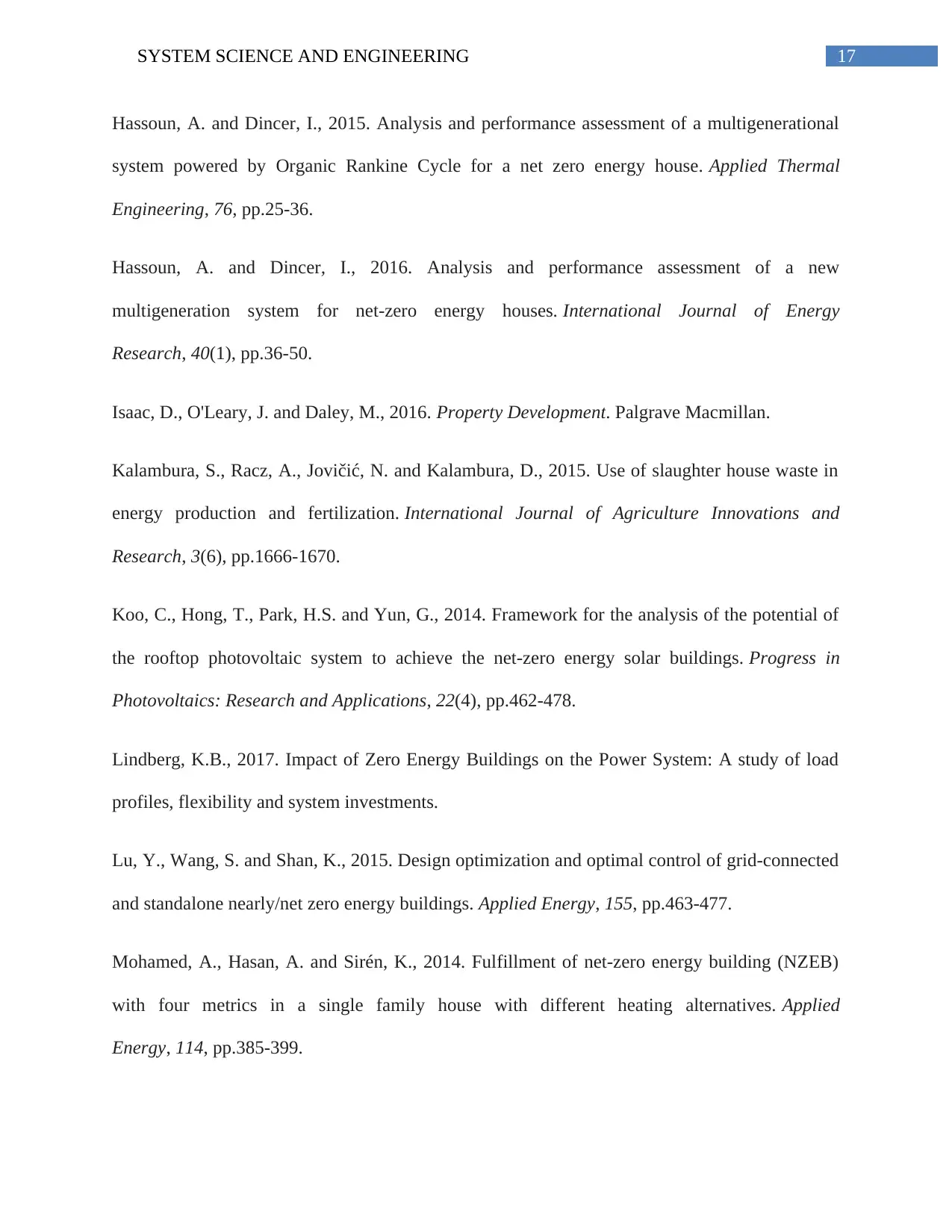
17SYSTEM SCIENCE AND ENGINEERING
Hassoun, A. and Dincer, I., 2015. Analysis and performance assessment of a multigenerational
system powered by Organic Rankine Cycle for a net zero energy house. Applied Thermal
Engineering, 76, pp.25-36.
Hassoun, A. and Dincer, I., 2016. Analysis and performance assessment of a new
multigeneration system for net‐zero energy houses. International Journal of Energy
Research, 40(1), pp.36-50.
Isaac, D., O'Leary, J. and Daley, M., 2016. Property Development. Palgrave Macmillan.
Kalambura, S., Racz, A., Jovičić, N. and Kalambura, D., 2015. Use of slaughter house waste in
energy production and fertilization. International Journal of Agriculture Innovations and
Research, 3(6), pp.1666-1670.
Koo, C., Hong, T., Park, H.S. and Yun, G., 2014. Framework for the analysis of the potential of
the rooftop photovoltaic system to achieve the net‐zero energy solar buildings. Progress in
Photovoltaics: Research and Applications, 22(4), pp.462-478.
Lindberg, K.B., 2017. Impact of Zero Energy Buildings on the Power System: A study of load
profiles, flexibility and system investments.
Lu, Y., Wang, S. and Shan, K., 2015. Design optimization and optimal control of grid-connected
and standalone nearly/net zero energy buildings. Applied Energy, 155, pp.463-477.
Mohamed, A., Hasan, A. and Sirén, K., 2014. Fulfillment of net-zero energy building (NZEB)
with four metrics in a single family house with different heating alternatives. Applied
Energy, 114, pp.385-399.
Hassoun, A. and Dincer, I., 2015. Analysis and performance assessment of a multigenerational
system powered by Organic Rankine Cycle for a net zero energy house. Applied Thermal
Engineering, 76, pp.25-36.
Hassoun, A. and Dincer, I., 2016. Analysis and performance assessment of a new
multigeneration system for net‐zero energy houses. International Journal of Energy
Research, 40(1), pp.36-50.
Isaac, D., O'Leary, J. and Daley, M., 2016. Property Development. Palgrave Macmillan.
Kalambura, S., Racz, A., Jovičić, N. and Kalambura, D., 2015. Use of slaughter house waste in
energy production and fertilization. International Journal of Agriculture Innovations and
Research, 3(6), pp.1666-1670.
Koo, C., Hong, T., Park, H.S. and Yun, G., 2014. Framework for the analysis of the potential of
the rooftop photovoltaic system to achieve the net‐zero energy solar buildings. Progress in
Photovoltaics: Research and Applications, 22(4), pp.462-478.
Lindberg, K.B., 2017. Impact of Zero Energy Buildings on the Power System: A study of load
profiles, flexibility and system investments.
Lu, Y., Wang, S. and Shan, K., 2015. Design optimization and optimal control of grid-connected
and standalone nearly/net zero energy buildings. Applied Energy, 155, pp.463-477.
Mohamed, A., Hasan, A. and Sirén, K., 2014. Fulfillment of net-zero energy building (NZEB)
with four metrics in a single family house with different heating alternatives. Applied
Energy, 114, pp.385-399.
1 out of 18
Related Documents
Your All-in-One AI-Powered Toolkit for Academic Success.
+13062052269
info@desklib.com
Available 24*7 on WhatsApp / Email
![[object Object]](/_next/static/media/star-bottom.7253800d.svg)
Unlock your academic potential
© 2024 | Zucol Services PVT LTD | All rights reserved.





